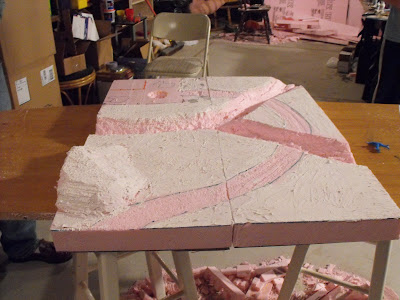For my next full size project I have chosen to work through the alternative mini-campaign at the back of the Rapid Fire book. I have always wanted to complete a campaign and this one seems to build nicely off the two previous projects I have worked on. I especially like the Bulge period because it featured primarily US forces and was the biggest operation of the war for most of the units involved. I am also fascinated by the "what-if's" of this period. Studying the German analysis of Allied dispositions before the offensive, it is striking how right the German High Command was. They struck at precisely the weakest link along the front, the discourse they speculated that would develop between the US and British commanders in fact occurred, and had it not been for the super-human effort of a few key pockets of resistance the offensive may well have succeeded.
So, my project sends us to the beginning of the offensive - 18th December 1944. What would have happened had Kampfgruppe Pieper not been stopped at the Neufmoulin Bridge? From there only 30 miles of road and one more bridge lay between Pieper's powerful force and the Meuse. Beyond the Meuse we know that forces were sparse.
Actual Events
There was only a small squad from 291st Combat Engineer Battalion that was stationed at the Neufmoulin Bridge. They had orders to blow the bridge at the first sign of German forces. Behind them, the 2nd Battalion of the 119th Regiment of the 30th Infantry Division was moving into positions where they could protect the assembly areas of the 82nd Airborne Division. Although originally assigned to Bastogne, the 82nd had been redirected to Werbomont after the 101st Airborne had reached Bastogne first. The 143rd Anti-Aircraft Artillery Battalion was also headed to Werbomont. The US had begun to use the 90mm guns from these units in an AT role.
Our Alternative
At the insistence of the Fuhrer, Panzer Brigade 150 was to lead the spearhead of Pieper's column. PB 150 was made up of captured US equipment and manned by German soldiers in Allied uniforms. Although annoyed by the delay, Pieper was counting on the extra gasoline that would come with waiting for the special unit to catch up. By December 18th, PB 150 was ready to lead the Kampfgruppe. At Neufmoulin Bridge, explosives had been in place for several days. The demolition party guarding the bridge had orders to blow the bridge at the first sign of German forces. It was late in the day when they saw an American Jeep racing towards them. It looked to them that the Jeep was carrying casualties. As they moved out into the road to offer assistance, a sudden burst of small arms fire cut them down. The Jeep raced across to the other side followed closely by a half-tack of SS Panzer Grenadiers. Pieper had his crossing out of the Ambleve Valley. (this account is abridged from Rapid Fire! Battle of the Bulge, Marsh, Richard and Rumford, Colin, 2007, Rapid Fire Publications Ltd, York, UK, pp 59-60.)
The campaign itself is four separate games where the German forces roll surviving units from one game to the next. Reinforcements are added along the way as the Germans face different opposition from the US forces. I have chosen to recreate only three of the four games for my campaign - Werbomont, Hamoir, and Amay. I am omitting a small scale battle at Soheit Tinlot because it did not seem to me to add much to the overall campaign. Also, for a convention, I could see running Game #1 on Friday, Game #2 on Saturday morning, and Game #3 Saturday afternoon/night. I also have both the Foy and Stoumont games that could fill in. Stoumont would be a prequel to the Werbomont battle and Foy would be an alternate ending if the German forces turn south at Hamoir instead of continuing west.
So, Game #1 is Werbomont. Werbomont is played on a 8x5 table. It represents Kampgruppe Pieper's first objective after crossing the Neufmoulin Bridge in the early evening of December 18th. Apart from the first few moves (a die roll will determine how many), this game takes place at night.
A recent order to Dave at Britannia has arrived with all of the figures and some additional vehicles for this game. You can see the order of battle in this photo.

I am waiting on another order from Hovels for a selection of bridges. I ended up ordering 28mm bridges, but that should not matter much. Once the order arrives, I will be starting the terrain pieces. I will be creating six 2.5 x 2.5 sections for this game. The terrain is going to be dominated by high ground on the river end and in the middle. There will be a road leading up the south (left) side of the board and another road twisting through the high-ground. Here is my sketch of the terrain layout.

From the OOB you can see that the German force is very strong. The US has a bunch of man-portable AT weapons though. Remember that the result of Game #2 hinges on how well the Germans can avoid casualties in the early stages. The loss of a few Panthers will make the next games more difficult. Victory conditions will certainly include something about the amount of casualties inflicted for the Americans.
I will probably hold off on my next post until significant progress has been made on the terrain. We have a local game coming up to test some of the rules and then Little Wars is our first convention of the year in April. After that we start detailed planing for our own second annual Day of Days Game Day scheduled for June 19. Slow and steady progress is the word for Werbomont, set to debut at RockCon in October. Check out our website (www.battlefieldhobbies.org) for more details on these.












